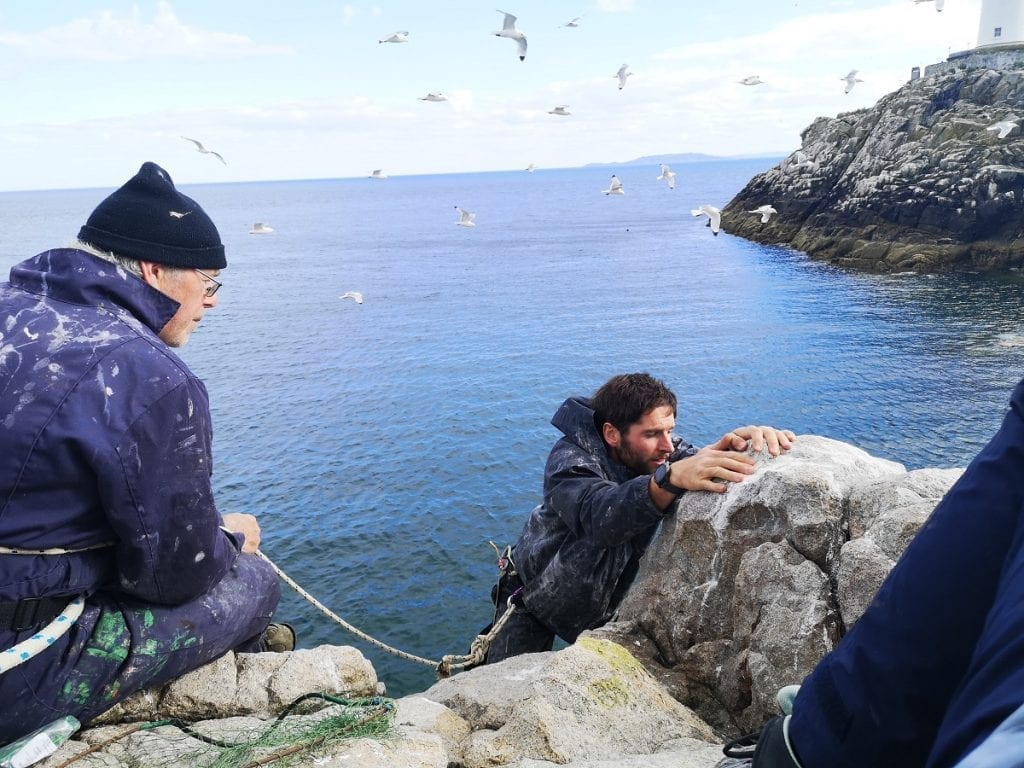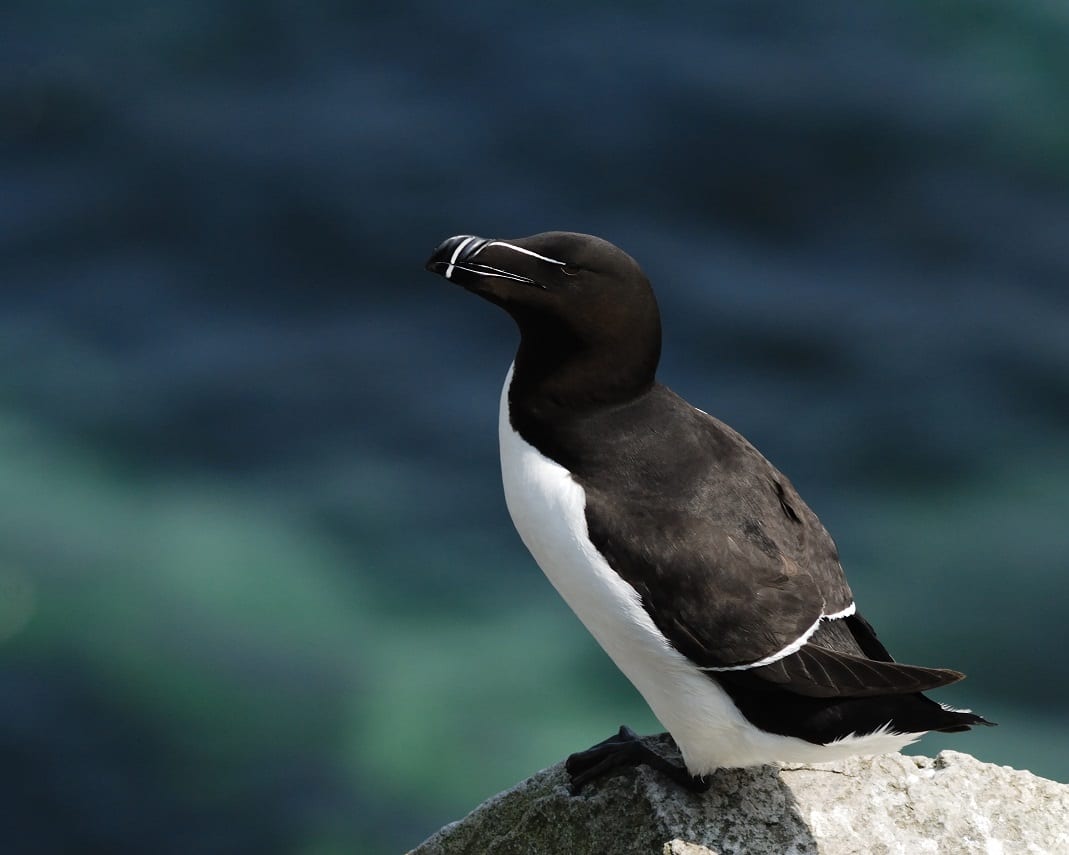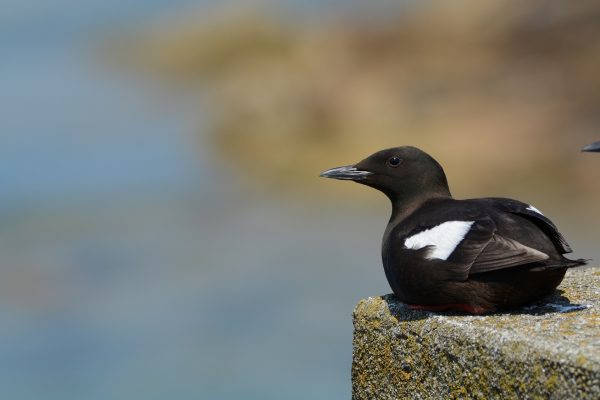
Black Guillemot
| Irish Name: | Foracha dhubh |
| Scientific name: | Cepphus grylle |
| Bird Family: | Auks |
amber
Conservation status
Conservation status
Status
Resident along all Irish coasts.
Identification
A species of Auk, highly marine and only found on land in the breeding season. Smaller than Guillemot, and only slightly bigger than Puffin. Plump and heavy at the rear end, flies with head pointing up. Strikingly distinctive in the breeding season, with an all black plumage, white upperwing patches and red feet. Can look all dark, at a distance, in the breeding season. Very different in the winter when the bird is white below with white barring above, upperwing pattern very similar to the breeding season and useful in identifying the species at that time of year.
Voice
Displaying birds voice a series of fine notes.
Diet
Marine fish and crustaceans.
Breeding
Nests amongst boulders at the base of cliffs, also in rock crevices and in man made structures, such as piers. Will nest singularly and in loose colonies.
Wintering
Winters in the vicinity of its breeding sites and can be seen inshore throughout the year.
Monitored by
Breeding seabirds are monitored through seabird surveys carried out every 15-20 years.
Blog posts about this bird

All Grown Up and Ready to Ring
Life continues to move fast out here on Rockabill. This year we recorded a record number of Roseate Tern nests on the island. That is a lot of chicks to watch over! Not only that, but each of these chicks need to be ringed with a uniquely coded leg ring so that we can continue to monitor them after they migrate and when they hopefully return to Rockabill to nest in the years to come. In no time at all our tiny tern chicks had shed their fluffy down feathers and had grown into their more elegant flight feathers.
Common tern chicks will start to wander away from their nest as early as 1 or 2 days old. Roseate tern chicks on the other hand will wait a bit longer and at 10 to 15 days old they will start to investigate the world outside their nest boxes.
It’s not just the terns, the Black Guillemots and Kittiwakes have also been getting very big, very fast.


The week concluded with the Steve and the volunteers’ departure, leaving the wardens to look after more and more fledglings by the day. However, we were not left for too long, as a few weeks later it was time to go climbing to ring some Kittiwake chicks. Dr. Stephen Newton returned with work experience student Hannah O’ Connor, who helped us earlier in the season with the nest census, and we set off. As Kittiwakes are cliff nesting seabirds, catching some of the chicks for ringing required some Micheal’s rock climbing expertise.
We set to work and over the course of two days, we ringed 174 Kittiwake chicks on the Bill and on the Rock.
While its always enjoyable to find fluffy Kittiwake chicks, the work was made a bit more difficult as we worked through the recent heatwave. At the end of each day the wardens and Hannah enjoyed a well-deserved swim in the sea. After a very sweaty few days, it was time for Dr Newton to leave us again and we were once again left to our own devices, this time, however, on an island bustling with teams of busy fledglings, as they took to the air for the first time.
 Common Tern chicks at different stages of their growth. Photos by Emma Tiernan, taken under NPWS license.
Common Tern chicks at different stages of their growth. Photos by Emma Tiernan, taken under NPWS license.
 Roseate tern chicks at different stages of their growth. Photos by Emma Tiernan & Alex Fink, taken under NPWS license.
Roseate tern chicks at different stages of their growth. Photos by Emma Tiernan & Alex Fink, taken under NPWS license.
Common tern chicks will start to wander away from their nest as early as 1 or 2 days old. Roseate tern chicks on the other hand will wait a bit longer and at 10 to 15 days old they will start to investigate the world outside their nest boxes.
 Common tern chick cosy under their parent on a cold day. Photo by Emma Tiernan, taken under NPWS license.
Common tern chick cosy under their parent on a cold day. Photo by Emma Tiernan, taken under NPWS license.
 Roseate tern chicks from the same clutch stepping outside their nest box for the first time. Photo by Emma Tiernan, taken under NPWS license.
Roseate tern chicks from the same clutch stepping outside their nest box for the first time. Photo by Emma Tiernan, taken under NPWS license.
It’s not just the terns, the Black Guillemots and Kittiwakes have also been getting very big, very fast.
 Black Guillemots at 5 days old (left) and over 15 days old (right) before getting weighed for biometrics analysis. Photos by Emma Tiernan, taken under NPWS license.
Black Guillemots at 5 days old (left) and over 15 days old (right) before getting weighed for biometrics analysis. Photos by Emma Tiernan, taken under NPWS license.
 Kittiwake chicks at 5 days old (left) and over 20 days old (right), now almost ready to fledge. Photos by Emma Tiernan & Alex Fink, taken under NPWS license.
Kittiwake chicks at 5 days old (left) and over 20 days old (right), now almost ready to fledge. Photos by Emma Tiernan & Alex Fink, taken under NPWS license.
Ringing Takes Time
As the tern chicks continued to grow throughout June it wasn’t long before it was time for the annual ringing blitz. While we had each ringed the majority of Roseate and common Tern chicks within our study areas, thousands of chicks still remained to be ringed around the rest of the island. We definitely would not be able to accomplish this with just the three of us. Thankfully, on the 28th of June, we were joined by Dr Stephen Newton, BirdWatch staff Brian Burke and Tara Adcock, and ringers Caroline McKeon and Thorfinn Newton to help us with this daunting task. Bird ringing is strictly licensed in Ireland through both the NPWS and BTO and requires extensive training before licenses are granted! We spent the next 3 days sweeping through each sub-colony of the island, systematically searching every box and nest location to catch and ring every Roseate and Common Tern chick that could be found. Once caught, the chicks were given a uniquely-coded metal ring and Dr. Newton recorded the ring number and other important details including the species, location and wing size (which gives us an idea of how many days old that chick is). Once ringed, the chick was released in its original setting and we moved on with our search. It was a tedious job, but with the help of the volunteers and some good weather, we managed to get the bulk of this ringing completed quickly. Warden Micheal Fitzgearld and ringer Caroline McKeon busy ringing Common and Roseate chicks. Photo by Emma Tiernan, taken under NPWS license.
Warden Micheal Fitzgearld and ringer Caroline McKeon busy ringing Common and Roseate chicks. Photo by Emma Tiernan, taken under NPWS license.

Tara Adcock ringing a young Common Tern chick. Photo by Emma Tiernan, taken under NPWS license.
Good News for our Arctic Terns
We are lucky to have thirty-seven Arctic Tern pairs nesting on the Rock this year. In previous breeding seasons, Arctic tern chicks out here have not been very lucky and most nest have been destroyed by either predation or wet weather. However, this year is looking good for our Arctic terns and 17 chicks have fledged. Fifteen Arctic chicks were fitted with BTO and special colour rings. Keep an eye out for some Arctic Terns along the East coast wearing a black ring with 2 white letters on the left leg. Dr Steven Newton colour ringing an Arctic Tern chick. Photo by Emma Tiernan, taken under NPWS license.
Dr Steven Newton colour ringing an Arctic Tern chick. Photo by Emma Tiernan, taken under NPWS license.
 An adult Arctic Tern with a colour ring (black 'E5') on the right leg. Hopefully this years fledglings will return to Rockabill in the coming years! Photo by Brian Burke, taken under NPWS license.
An adult Arctic Tern with a colour ring (black 'E5') on the right leg. Hopefully this years fledglings will return to Rockabill in the coming years! Photo by Brian Burke, taken under NPWS license.
Climbing for Kittiwakes
There were more than just Tern chicks to ring however, and with the majority of this work completed we set about catching adult Kittiwakes from the cliff tops on the Rock. Kittiwakes are now globally red-listed, so we’re trying to increase our monitoring of this beautiful gull on Rockabill. As well as ringing them, we also attached GLS tags to each one so that their movements over the next fifteen months could be tracked. All in all, we caught twenty of these beautiful birds over the course of two days.
 Kittiwake with a GLS tag (on the green ring), plus identifying metal and colour rings, before being released back into the colony. Photo by Brian Burke.
Kittiwake with a GLS tag (on the green ring), plus identifying metal and colour rings, before being released back into the colony. Photo by Brian Burke.
The week concluded with the Steve and the volunteers’ departure, leaving the wardens to look after more and more fledglings by the day. However, we were not left for too long, as a few weeks later it was time to go climbing to ring some Kittiwake chicks. Dr. Stephen Newton returned with work experience student Hannah O’ Connor, who helped us earlier in the season with the nest census, and we set off. As Kittiwakes are cliff nesting seabirds, catching some of the chicks for ringing required some Micheal’s rock climbing expertise.
 Warden Micheal Fitzgerald has been a keen rock climber for years and was looking forward to climbing cliffs for Kittiwakes, Photo by Emma Tiernan.
Warden Micheal Fitzgerald has been a keen rock climber for years and was looking forward to climbing cliffs for Kittiwakes, Photo by Emma Tiernan.
We set to work and over the course of two days, we ringed 174 Kittiwake chicks on the Bill and on the Rock.
 The Rockabill team ringing Kittiwake chicks while Micheal waits to carefully put them back in their nests. Photo by Emma Tiernan, taken under NPWS license.
The Rockabill team ringing Kittiwake chicks while Micheal waits to carefully put them back in their nests. Photo by Emma Tiernan, taken under NPWS license.
While its always enjoyable to find fluffy Kittiwake chicks, the work was made a bit more difficult as we worked through the recent heatwave. At the end of each day the wardens and Hannah enjoyed a well-deserved swim in the sea. After a very sweaty few days, it was time for Dr Newton to leave us again and we were once again left to our own devices, this time, however, on an island bustling with teams of busy fledglings, as they took to the air for the first time.
- Micheal, Emma and Alex, Rockabill Team
(PS – Don’t forget to keep an eye out for terns roosting around the coast at this time of year, and let us know via the link here)This year’s work to protect and monitor the terns and other breeding seabirds on Rockabill would not be possible without support from the National Parks and Wildlife Service and the cooperation of the Commissioners of Irish Lights.
To revisit news and blogs from previous years on Rockabill, click the link here.
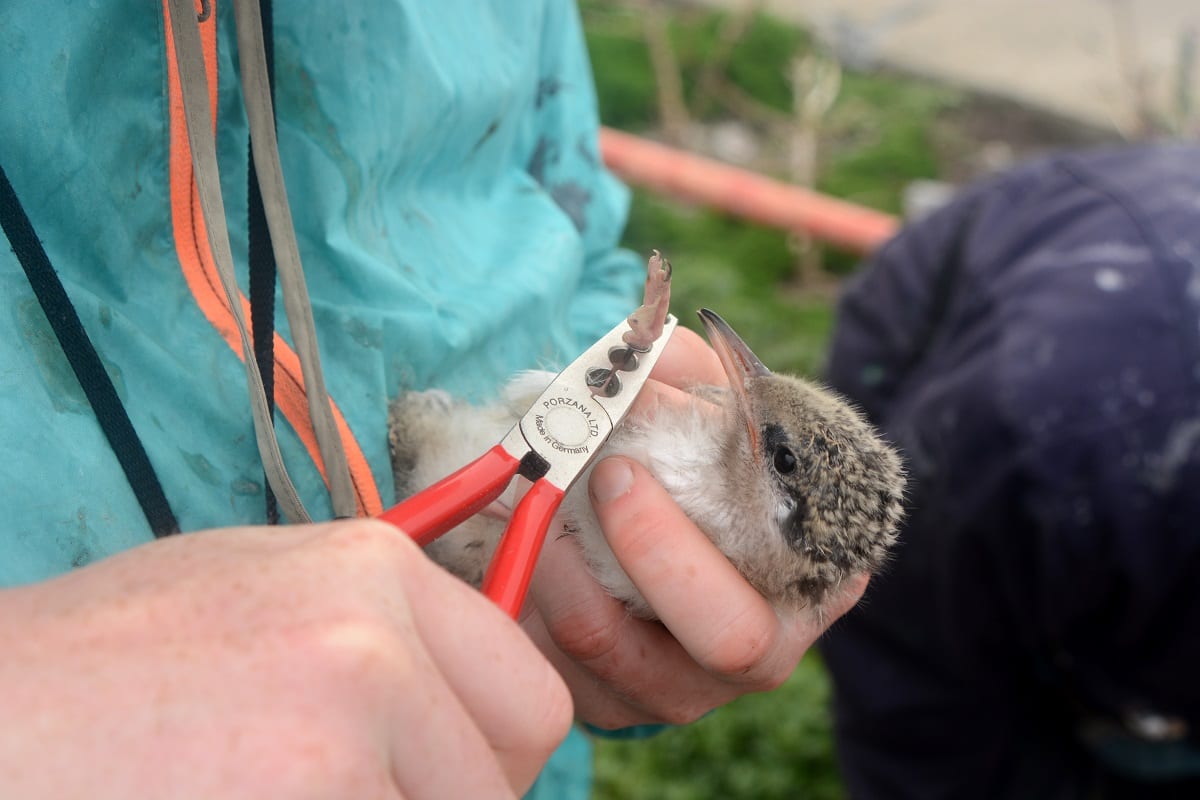
Rockablog - Ringing Blitz Bonanza!
It has been an exciting time on Rockabill with the annual ringing blitz taking place during the first week of July. The three wardens were joined by BirdWatch Ireland staff and experienced ringers Dr. Steve Newton and Brian Burke. Enna O’Conner also joined us a volunteer and proved an extraordinarily efficient scribe! The goal of the ringing blitz is to ring every single one of the Tern chicks on the Island in about two days. By giving all of the chicks a tiny, uniquely-coded leg ring, it means we can continue to learn about them through their lifetime. Do chicks hatched on Rockabill come back here to nest? Do they go to other colonies? What age are birds in the Rockabill colony? Do they pair with birds of a similar age? Do younger or older birds have better breeding success? And of course, they might get seen or caught on migration too, helping to confirm migration patterns and help fill in gaps in our knowledge. For the bird, wearing a leg ring is like a person wearing a watch - after you first put it on you forget it's even there. Bird ringing is strictly licensed in Ireland through both the NPWS and BTO and requires extensive training before licenses are granted!

In total 146 Common Tern chicks and 619 Roseate Tern Chicks were ringed in the two day period. This is much lower than most years, and we'll get into that in a future blog... Following the blitz it is the wardens job to find any other chicks that don’t have rings and ring them as needed. Some will have been missed during the original blitz, and others will have hatched in the weeks since. The wardens will sweep the entire island a couple more times and also pick up chicks as they are walking through, working or ring reading in the colony. They are still finding chicks to ring today as the late nest chicks are hatching and growing.


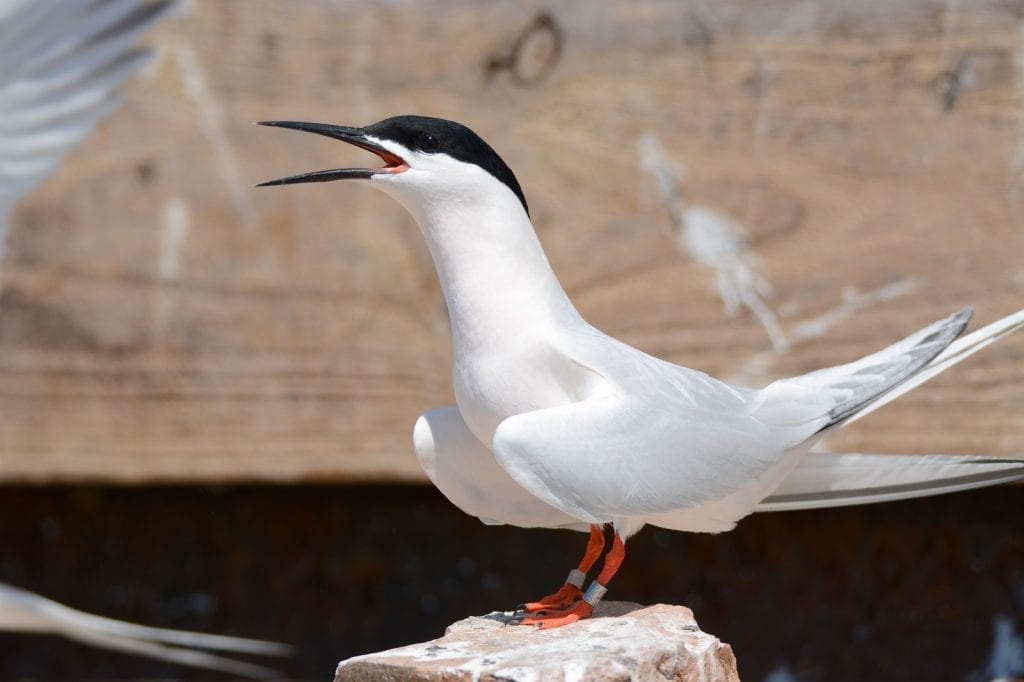
Roseate Tern adult - note the leg rings, which allow us to keep learning from these birds throughout their lifetime. (B. Burke, photo taken under NPWS license).
The process starts by lining up and sweeping through each subcolony, picking up as many chicks as possible as the team moves through the area. The smaller birds are easy to catch as they freeze or try to hide under leaves or rocks, but the larger, braver chicks often make dash for safety. A person is needed on each side to 'herd' the chicks for an easier catch. Once caught, Enna gave the ringer a uniquely coded ring and recorded the species, location, wing size and other important details while others ringed the chick, placed it back in its original setting and moved on with our grid searching. It proved to be a very busy few days! Roseate (left, right) and Common Tern (middle) chicks trying to hide as the wardens approach! (K. Owens, photos taken under NPWS license)
Roseate (left, right) and Common Tern (middle) chicks trying to hide as the wardens approach! (K. Owens, photos taken under NPWS license)
In total 146 Common Tern chicks and 619 Roseate Tern Chicks were ringed in the two day period. This is much lower than most years, and we'll get into that in a future blog... Following the blitz it is the wardens job to find any other chicks that don’t have rings and ring them as needed. Some will have been missed during the original blitz, and others will have hatched in the weeks since. The wardens will sweep the entire island a couple more times and also pick up chicks as they are walking through, working or ring reading in the colony. They are still finding chicks to ring today as the late nest chicks are hatching and growing.

Kittiwake chicks on Rockabill - most are well grown now and are sporting new leg rings! (K. Owens, photos taken under NPWS license)
In the following weeks after the Tern-ringing blitz, project manager Steve returned to Rockabill to ring the Kittiwake and Guillemot chicks with the help of the wardens. There are much fewer of these chicks but they are however a bit more difficult to get to! Staff were climbing up and down rock faces and putting their arms in long dark holes to retrieve these birds out of their nests. A total of 94 Kittiwake chicks and 72 Black Guillemot chicks were ringed this year.Warden George, carefully accessing some Kittiwake nests on the cliff in order to ring the chicks (K. Owens)
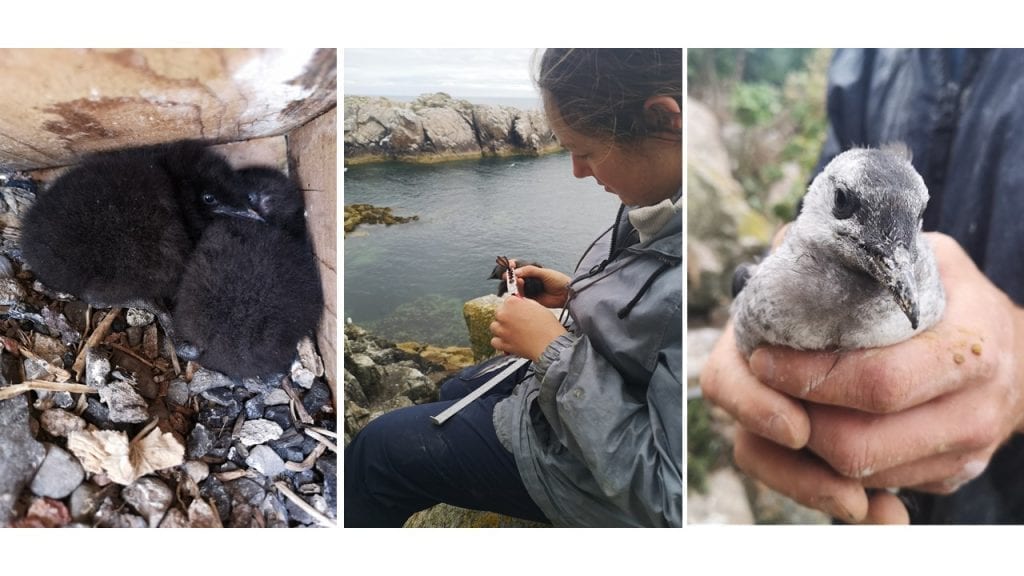
Ringing Black Guillemot chicks on Rockabill (K. Owens, photos taken under NPWS license)
Now that almost all the chicks on the island are ringed and starting to fly it is nearing time to pack up and leave. The wardens have started bringing in nesting boxes to clean and store for next season. There is also a lot of data collation and report writing going on, it is nice to see the chicks start to fly but sad to see the absence of young chicks around. Stay tuned for the next blog which will be the last one of the season!- Kristy & the Rockabill team
(PS - Don't forget to keep an eye out for terns roosting around the coast at this time of year, and let us know! See here for more)This year's work to protect and monitor the terns and other breeding seabirds on Rockabill would not be possible without the Roseate Tern EU LIFE project, support from the National Parks and Wildlife Service and the cooperation of the Commissioners of Irish Lights.
To revisit news and blogs from previous years on Rockabill, click the link here.

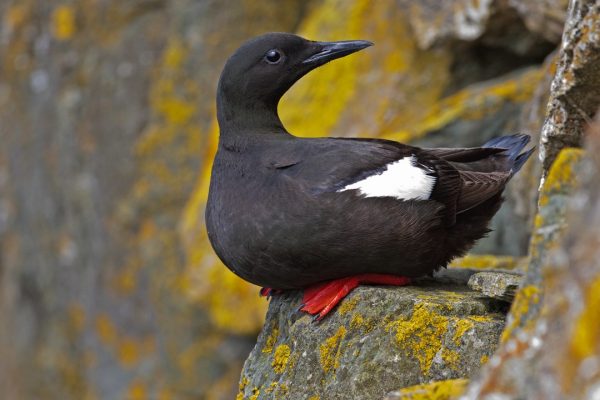

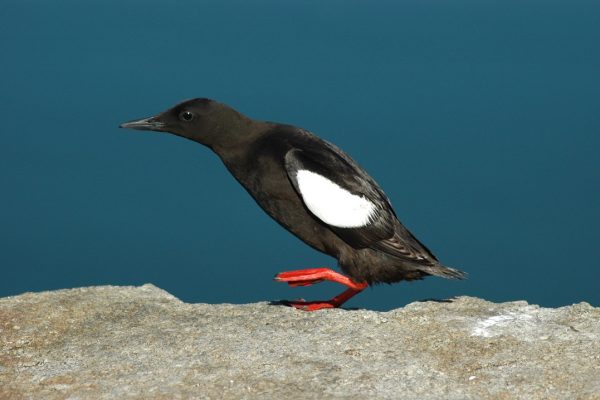

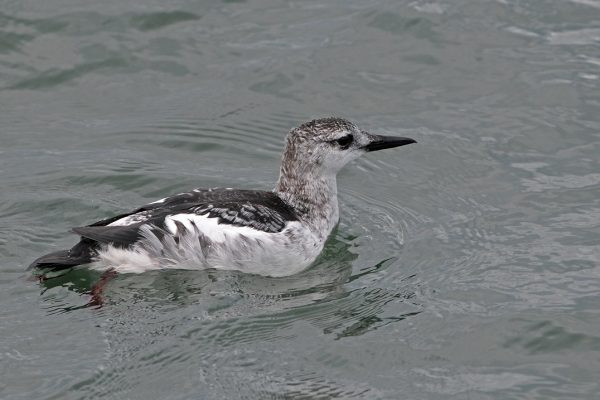

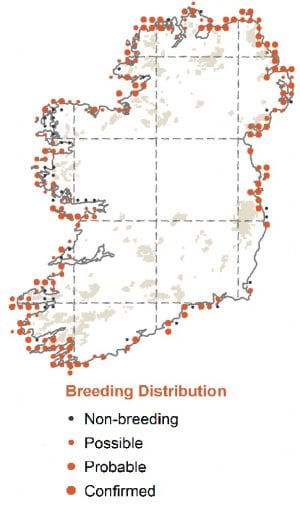
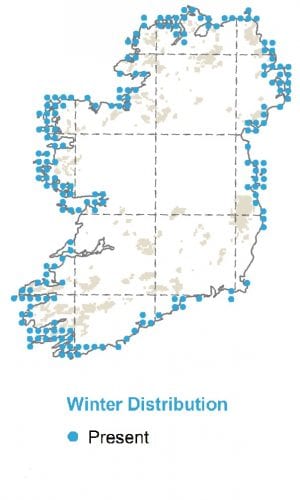
 Common Tern chicks at different stages of their growth. Photos by Emma Tiernan, taken under NPWS license.
Common Tern chicks at different stages of their growth. Photos by Emma Tiernan, taken under NPWS license. Roseate tern chicks at different stages of their growth. Photos by Emma Tiernan & Alex Fink, taken under NPWS license.
Roseate tern chicks at different stages of their growth. Photos by Emma Tiernan & Alex Fink, taken under NPWS license. Common tern chick cosy under their parent on a cold day. Photo by Emma Tiernan, taken under NPWS license.
Common tern chick cosy under their parent on a cold day. Photo by Emma Tiernan, taken under NPWS license. Roseate tern chicks from the same clutch stepping outside their nest box for the first time. Photo by Emma Tiernan, taken under NPWS license.
Roseate tern chicks from the same clutch stepping outside their nest box for the first time. Photo by Emma Tiernan, taken under NPWS license. Black Guillemots at 5 days old (left) and over 15 days old (right) before getting weighed for biometrics analysis. Photos by Emma Tiernan, taken under NPWS license.
Black Guillemots at 5 days old (left) and over 15 days old (right) before getting weighed for biometrics analysis. Photos by Emma Tiernan, taken under NPWS license.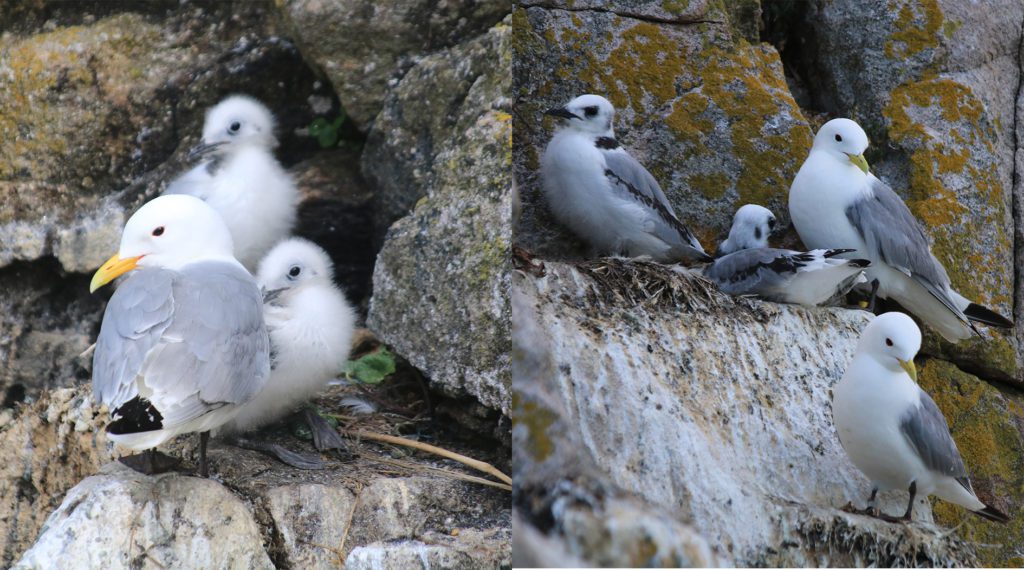 Kittiwake chicks at 5 days old (left) and over 20 days old (right), now almost ready to fledge. Photos by Emma Tiernan & Alex Fink, taken under NPWS license.
Kittiwake chicks at 5 days old (left) and over 20 days old (right), now almost ready to fledge. Photos by Emma Tiernan & Alex Fink, taken under NPWS license. Warden Micheal Fitzgearld and ringer Caroline McKeon busy ringing Common and Roseate chicks. Photo by Emma Tiernan, taken under NPWS license.
Warden Micheal Fitzgearld and ringer Caroline McKeon busy ringing Common and Roseate chicks. Photo by Emma Tiernan, taken under NPWS license. Dr Steven Newton colour ringing an Arctic Tern chick. Photo by Emma Tiernan, taken under NPWS license.
Dr Steven Newton colour ringing an Arctic Tern chick. Photo by Emma Tiernan, taken under NPWS license.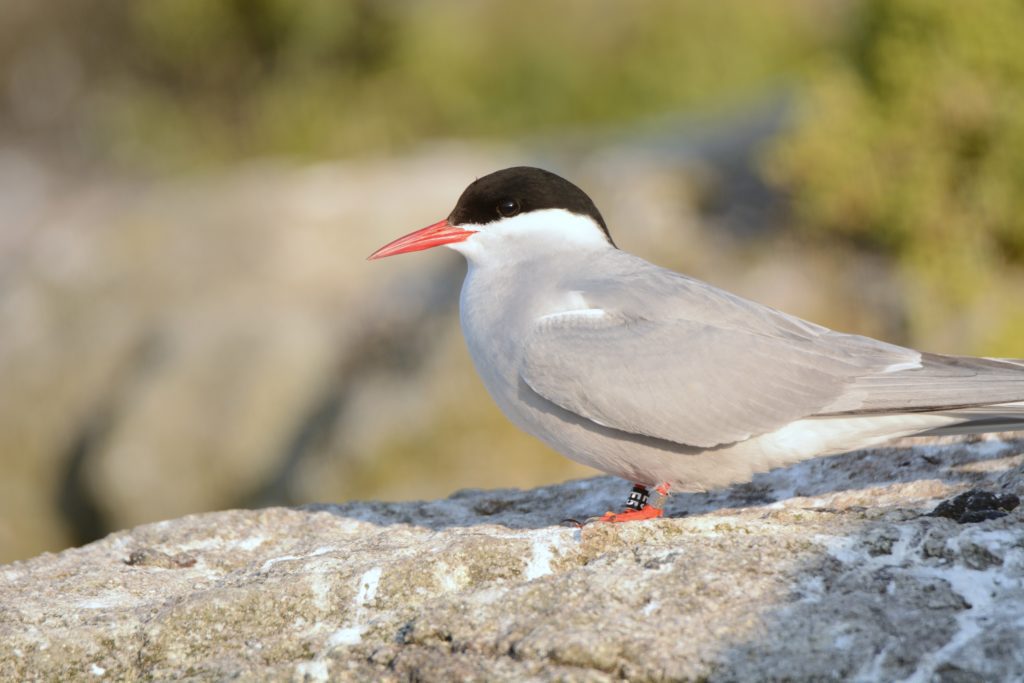 An adult Arctic Tern with a colour ring (black 'E5') on the right leg. Hopefully this years fledglings will return to Rockabill in the coming years! Photo by Brian Burke, taken under NPWS license.
An adult Arctic Tern with a colour ring (black 'E5') on the right leg. Hopefully this years fledglings will return to Rockabill in the coming years! Photo by Brian Burke, taken under NPWS license.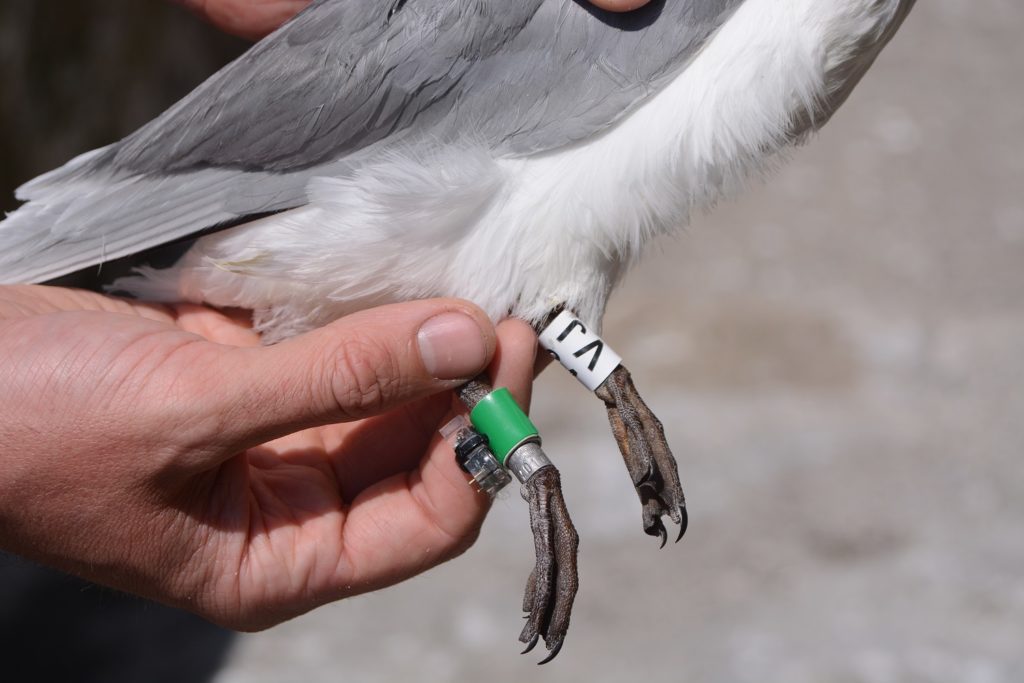 Kittiwake with a GLS tag (on the green ring), plus identifying metal and colour rings, before being released back into the colony. Photo by Brian Burke.
Kittiwake with a GLS tag (on the green ring), plus identifying metal and colour rings, before being released back into the colony. Photo by Brian Burke. Warden Micheal Fitzgerald has been a keen rock climber for years and was looking forward to climbing cliffs for Kittiwakes, Photo by Emma Tiernan.
Warden Micheal Fitzgerald has been a keen rock climber for years and was looking forward to climbing cliffs for Kittiwakes, Photo by Emma Tiernan. The Rockabill team ringing Kittiwake chicks while Micheal waits to carefully put them back in their nests. Photo by Emma Tiernan, taken under NPWS license.
The Rockabill team ringing Kittiwake chicks while Micheal waits to carefully put them back in their nests. Photo by Emma Tiernan, taken under NPWS license.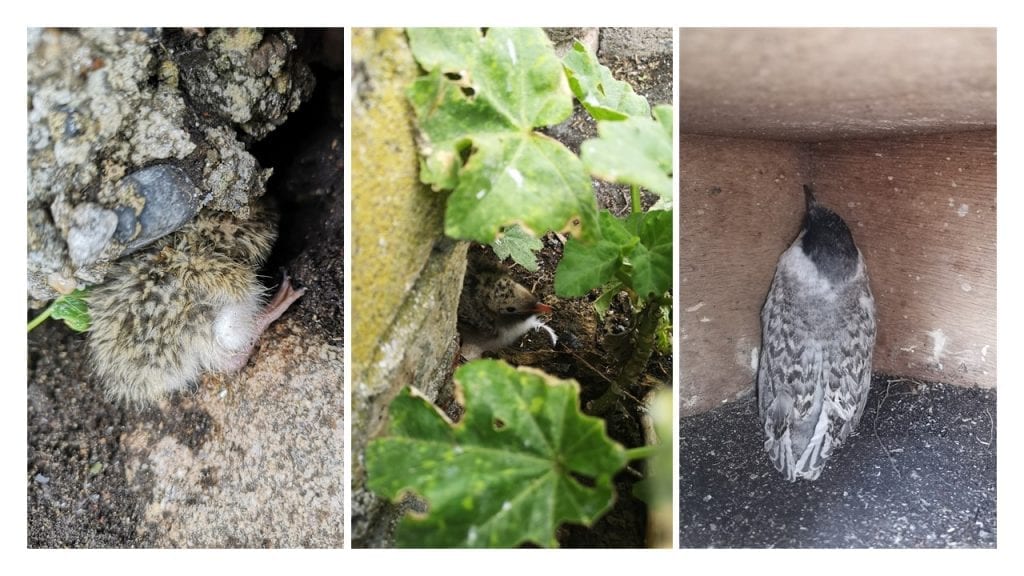 Roseate (left, right) and Common Tern (middle) chicks trying to hide as the wardens approach! (K. Owens, photos taken under NPWS license)
Roseate (left, right) and Common Tern (middle) chicks trying to hide as the wardens approach! (K. Owens, photos taken under NPWS license)